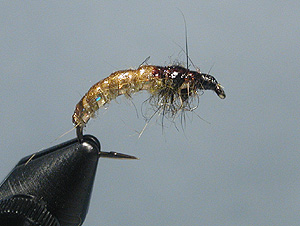
On The Fly
"Fly tying is a school from which we never graduate"
TYING NEWS
The Southern Oregon Fly Tiers met Tuesday July 10th at the Madrone Hill community building near Gold Hill. This location is working out great, with plenty of room for more tiers. We encourage novice and experienced tiers alike to drop by the second Tuesday of each month for a fun evening. The next meeting will be on Tuesday, August 14th.
 PATTERN OF THE MONTH - Czech Nymph
PATTERN OF THE MONTH - Czech Nymph
Hook: TMC 2457 or equal, #8-12,
caddis pupae.
Weight: Adhesive-backed lead tape.
Thread: 6/0 white.
Shellback: Olive scud back; Thin Skin; Flex Body or
Body Stretch.
Rib:
Flat gold holographic tinsel and 5x mono tippet.
Abdomen: Golden olive dubbing.
Thorax: Squirrel dubbing, dark olive.
Marking pen: Dark brown.
Tying Instructions:
1.Cut a strip of adhesive-backed lead tape about 1/16-inch wide by
3-inches long. Remove the paper backing and start the wraps partially
down the bend of the hook. Wrap one layer towards the eye and a second
layer back but stop short of the starting point. Use a third layer for
larger hooks.
2.Start the thread and wrap over the lead to create a thin tapered body
halfway down the body.
3.Trim a point on the end of the shellback material and tie the material
on top of the hook with equal portions of material on both sides of the
hook. Wrap the thread back over the shellback material while stretching
the material as you go.
4.Tie in the ribs (there are two): the holographic tinsel, which goes
under the shellback, and the 5x tippet, which goes over the shellback to
form segmentation.
5.Form a dubbing loop and insert a sparse amount of golden olive
dubbing, and wind on evenly to cover 2/3 to 3/4 of the body. Avoid creating
lumps and bumps.
6.Form another shorter dubbing loop for the thorax and use the darker,
spikier squirrel dubbing. No need for bulk. Wrap the dubbing forward to
create a thorax the same thickness as the abdomen.
7.Wrap the tinsel forward in five even wraps over the abdomen and
thorax. Tie off
.
8.Fold the shellback forward over the back keeping it centered. Stretch
it slightly and tie off with tight turns. Hold the stretch while you
trim the tag end of the shellback material.
9.Wind the mono forward keeping the wraps between the tinsel wraps. Tie
off and trim.
10.Pick out the thorax to free up some of the guard hairs, offering the
illusion of legs.
11.Form a neat head, whip-finish and apply head cement.
12.Use the marker to color the top of the thorax.
The Czech nymph was developed at the beginning of the 21st century in the Czech Republic and Poland for fishing in moderate to fast water. The flies they created mimic many of the caddis nymphs, caddis pupa and fresh water shrimps that inhabit most waters all over the world. The fly was designed for the Czech nymphing method.
Czech nymphing is a specific type of fishing that was also developed in Eastern Europe. The tactic is sometimes referred to as high stick or tight line nymphing. In this method you use a floating line and no indicator, and you make a short cast with only 10 feet or so extending beyond the rod tip. You cast upstream and follow the fly with the rod. To feel the strike you need to keep the line tight for the entire drift.
All Czech nymphs adhere to a few simple principles: They are heavy, they are slim, they sport some sort of darker shellback and they are tied on a curved, “grub style” hook. Beyond that, the variations and color combinations are endless. Try tying the “hot spot” version using a fluorescent Light Bright or Seal Fur between the body and thorax area. So tie some up, give them a test flight and let me know how you do.
TYING TIPS
Ribbing the shellback with high tension can shift or
deform the softer material. Start wrapping softly over the top and
around the backside; pull up strongly on the nearside. When you pick out
the thorax be careful not to break the thread or ribbing. Reminder:
Don’t use your good scissors to cut lead or mono.
Tie One On,
Dan Kellogg (you can contact me at FLYGUY@EZNORTHWEST.COM)